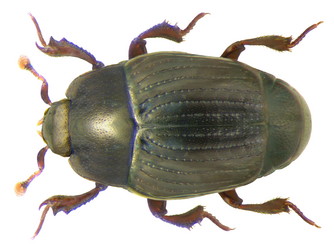Paromalini
Michael S. Caterino- Athomalus
- Cryptomalus
- Diplostix
- Pachylomalus
- Platylomalus
- Xestipyge
- Coomanister
- Carcinops
- Eutriptus
- Australomalus
- Eulomalus
- Paromalus
- Kissister
Introduction
Species of Paromalini are small, poorly known histerids. Many in the New World tropics are associated with dead or dying wood. Many occur under bark or are associated with rotting cactus. Species of Carcinops are especially common in the latter situation, although one species, C. pumilio, prefers dung, and has proven useful in poultry houses to aid in fly control (Peck & Anderson, 1969).
Characteristics
Most species of this group are small (<4mm), slightly to extremely (Platylomalus) flattened, and brown to black (some Carcinops are metallic blue or green). They possess labral setae, outwardly arcuate antennal club annuli, and have a pronounced prosternal lobe which does not extend laterally to cover the antennal cavities, and which bears lateral notches which receive the large protibial spur when the legs are retracted.
References
Caterino, M. S., and A. P. Vogler. 2002. The phylogeny of the Histeroidea. Cladistics 18(4):394-415.
Peck, J. H., and J. R. Anderson. 1969. Arthropod predators of immature Diptera developing in poultry droppings in northern California. Part 1. Determination, seasonal abundance, and natural cohabitation with prey. Journal of Medical Entomology 6:163-167.
Title Illustrations

| Scientific Name | Carcinops pumilio |
|---|---|
| Location | Germania, Bayern, Oberfranken, Schwarzenbacg a. Wald |
| Creator | U. Schmidt |
| Specimen Condition | Dead Specimen |
| Identified By | U. Schmidt |
| Size | 2-2.5 mm |
| Collector | U. Schmidt, 2004 |
| Source | Carcinops pumilio |
| Source Collection | Flickr |
| Image Use |
 This media file is licensed under the Creative Commons Attribution-NonCommercial-ShareAlike License - Version 2.0. This media file is licensed under the Creative Commons Attribution-NonCommercial-ShareAlike License - Version 2.0.
|
| Copyright | © 2008 urjsa |
About This Page

Santa Barbara Museum of Natural History, Santa Barbara, California, USA
Page copyright © 2002
 Page: Tree of Life
Paromalini.
Authored by
Michael S. Caterino.
The TEXT of this page is licensed under the
Creative Commons Attribution License - Version 3.0. Note that images and other media
featured on this page are each governed by their own license, and they may or may not be available
for reuse. Click on an image or a media link to access the media data window, which provides the
relevant licensing information. For the general terms and conditions of ToL material reuse and
redistribution, please see the Tree of Life Copyright
Policies.
Page: Tree of Life
Paromalini.
Authored by
Michael S. Caterino.
The TEXT of this page is licensed under the
Creative Commons Attribution License - Version 3.0. Note that images and other media
featured on this page are each governed by their own license, and they may or may not be available
for reuse. Click on an image or a media link to access the media data window, which provides the
relevant licensing information. For the general terms and conditions of ToL material reuse and
redistribution, please see the Tree of Life Copyright
Policies.
- First online 07 March 2002
Citing this page:
Caterino, Michael S. 2002. Paromalini. Version 07 March 2002 (under construction). http://tolweb.org/Paromalini/9383/2002.03.07 in The Tree of Life Web Project, http://tolweb.org/








 Go to quick links
Go to quick search
Go to navigation for this section of the ToL site
Go to detailed links for the ToL site
Go to quick links
Go to quick search
Go to navigation for this section of the ToL site
Go to detailed links for the ToL site